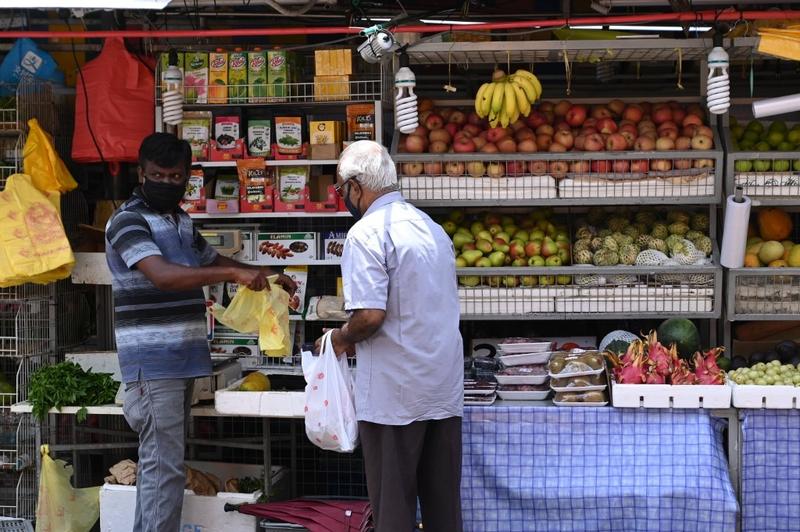 A vendor wearing a protective facemask amid fears about the spread of the COVID-19 coronavirus serves a customer at a fruit stall in Singapore on May 8, 2020. (ROSLAN RAHMAN / AFP)
A vendor wearing a protective facemask amid fears about the spread of the COVID-19 coronavirus serves a customer at a fruit stall in Singapore on May 8, 2020. (ROSLAN RAHMAN / AFP)
Singapore remains committed to its approach to selectively test individuals with symptoms of the coronavirus as it has yielded results, and hasn’t made any major decisions to pivot to mass testing.
“We cannot be testing aimlessly,” the city-state’s health minister Gan Kim Yong said at a press conference on Friday.
The country’s aim to increase testing fivefold from 8,000 a day to 40,000 by later this year comes amid a global shortage of test kits and materials
Outlining the nation’s testing strategy, Gan said the government is looking to sieve out positive cases, identify close contacts and quarantine them. It will also look out for negative cases and allow workers to go back to work as it seeks to progressively re-open its economy.
Minister for Trade and Industry Chan Chun Sing on April 24 suggested the city-state is pondering mass tests, with “much more testings for the entire population and at the same time to take on” additional safe distancing measures.
Singapore now has one of the largest outbreaks in Asia following a resurgence in infections, primarily among low-wage migrant workers staying in cramped dormitories. It reported 768 new cases on Friday, bringing the total reported infections in the country to nearly 22,000. To decisively bring down the numbers, Singapore has extended its partial lockdown -- now into its fifth week -- until June 1.
The surge in cases, coupled with plans to re-open its economy, has prompted the city-state to scale up tests. The country’s aim to increase testing fivefold from 8,000 a day to 40,000 by later this year comes amid a global shortage of test kits and materials.
Selective Testing
Singapore is committed to continuing its selective testing strategy, the health ministry’s director of medical services Kenneth Mak said at the press conference.
“Our selective testing strategies have given us quite a yield. It’s not like that hasn’t worked out,” he said.
“As we move on eventually, to a later period of time, in terms of when we normalize, our testing strategies would have to be reviewed and fine-tuned,” he said. “We haven’t made any major decisions about mass testing.”
Though Singapore’s scaling up testing efforts, its game plan is different from the mass testing adopted by countries like South Korea, where people can request to be tested.
The government is looking at vulnerable groups such as elderly people residing in nursing homes and the homeless as well as frontline workers caring for infected patients.
“When we talk about mass testing, it’s not everyone raise your hand and apply for a test. It shouldn’t be like that,” National Development Minister Lawrence Wong, who co-chairs a government taskforce tackling the virus, said at the press conference.
“It has to be directed,” he said. “Testing will be a national resource, which we will apply in a strategic way to ensure that Singapore is safe from the virus.”
ALSO READ: Singapore's 'hooligan cook' offers meals for needy amid lockdown
Nursing Homes
The city-state will progressively test all 16,000 seniors staying in nursing homes as well as 5,000 other residents and staff in welfare, shelter and adult disability homes. Currently, 9,000 employees of nursing homes have been tested.
Even as it plans to expand to 40,000 tests a day, supplies have to be allocated to “areas of priority,” Wong said. Aside from vulnerable groups, others include those with respiratory illness, and migrant workers where repeated tests are needed even though they’ve been cleared.
The goal is to ensure that large virus clusters do not form again, Wong said. Test kits will also have to be allocated for workers in essential services such as waste management, logistics and finance.
Circuit Breaker
Singapore will consider lifting its so-called “circuit breaker” measures if certain criteria are fulfilled, including reduced transmission of the virus in the wider community as well as among the migrant workers in the dormitories.
Some workplaces and services will resume operations from May 12, while certain groups of students will be allowed to return to school the following week.
READ MORE: Singapore's cases top 10,000 as worker infections rise
Sectors such as manufacturing, which require workers to be onsite, should meanwhile start making preparations for the gradual reopening of the economy in the coming weeks, Trade and Industry Minister Chan Chun Sing has said.


